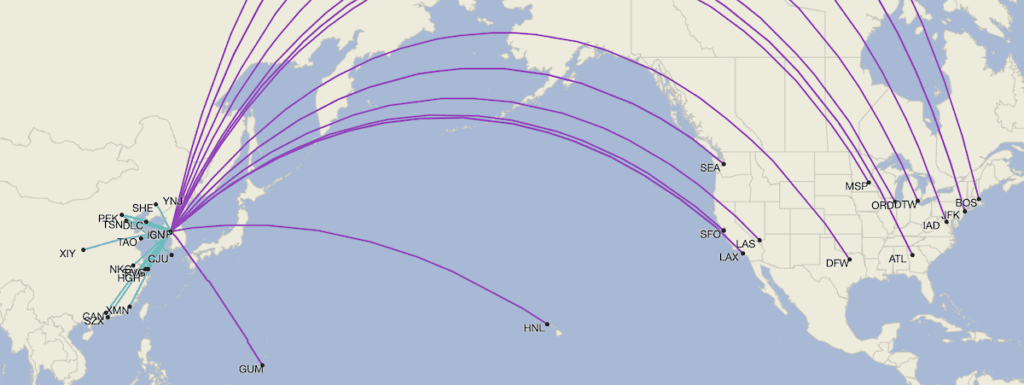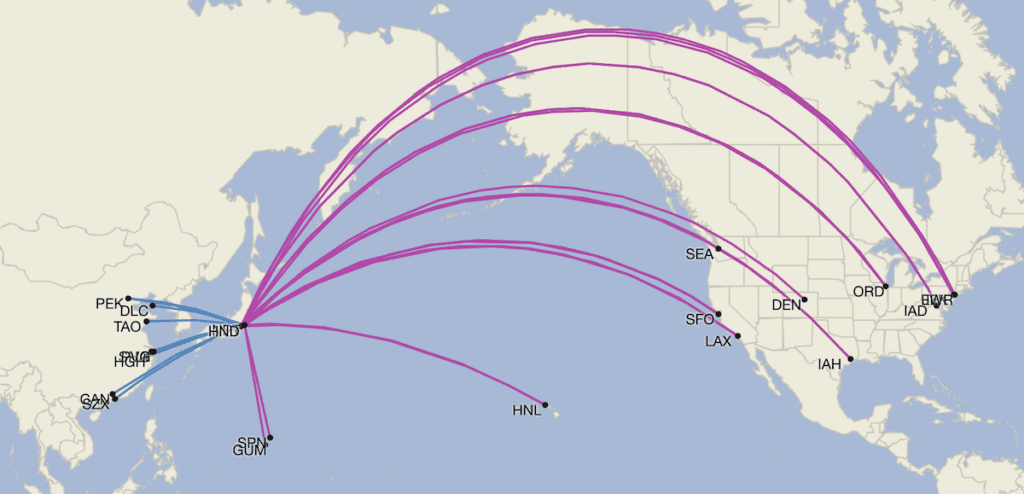Korean Air, Japanese Airlines Could Benefit From Limits on U.S.-China Flights

Photo Credit: Flickr / keso s
Korean Air, in the late 1970s, lured Western travelers with a "Seoul Shortcut." It was making reference to the advantageous location of its Seoul hub, for routes between North America and Asia.
Fast-forward 40-some years and Seoul remains ideally situated for North America-Asia flight connections. One only has to look as far as the Korean Air and Delta Air Lines transpacific joint venture, and the latter's decision to funnel U.S.-Asia traffic into Seoul, to see the strength of that location. Tokyo benefits from the same geographic advantage with partners All Nippon Airways and United Airlines, and Japan Airlines and American Airlines, pushing connections over the city's Narita and Haneda airports.
Seoul and Tokyo's geographic strengths as connecting hubs remain unchanged. Now, as air travel in Asia rebounds from the Covid pandemic, western geopolitical tensions with both China and Russia stand to benefit both gateways and their local carriers.
Pandemic caps on flights between China and the U.S. remain in place amid strained relations between the countries. Before Covid, there were up to 50 flights a day between the countries; today there are only 20 flights per week, Diio by Cirium schedules show. Both Chinese and U.S. airlines want to resume more flights but, as yet, their governments won't allow them.
At the same time, travel demand between the countries has surged since China eased border restrictions in January. The latest data from the U.S. International Trade Administration show that the number of passengers arriving or departing on nonstop flights with China jumped nearly fourfold to more than 48,000 people in January and February compared to a year earlier when border restrictions were in place. The numbers do not include travelers who connect in a third country, like Japan or South Korea. In January and February 2019, 1.34 million people flew on nonstop flights between China and the U.S.
The result is a classic imbalance in supply — of nonstop seats — and demand for U.S.-China travel.
ANA, JAL, and Korean Air, with their Tokyo and Seoul hubs, sit conveniently in the middle. No other hubs are as conveniently placed. For example, Cathay Pacific Airways' Hong Kong hub offers similar connectivity but its location adds multiple hours to most trips between the U.S. and China. In addition, none of the three carriers face similar limits on flights or frequencies; in fact, China and South Korea agreed in March to allow for the restoration of all pre-pandemic flights.
By June, JAL is scheduled to operate 62 percent of its 2019 flights, Korean Air 46 percent, and ANA 22 percent, according to Diio. Note that JAL was half the size of ANA to China before the crisis, and thus has to resume fewer flights to achieve a higher percentage recovered.
Korean Air, the largest of the three airlines to China before the Covid crisis, will resume more of its schedule as demand warrants and the remaining restrictions ease, a spokesperson said. For example, China still requires a negative Covid test for all arriving travelers, and non-Chinese travelers face a backlog of visa applications. The spokesperson added that, while U.S.-China connecting flows have not fully recovered, Korean Air expects numbers to increase.
Delta, Korean Air's U.S. partner, is limited to just four weekly flights to China — two a week from Detroit, and two from Seattle — according to Diio. That compares to six daily flights in 2019. Delta has resumed its full Seoul schedule of a daily flight each from Atlanta, Detroit, Minneapolis-St. Paul, and Seattle.

"There is a great increase in the travel flows between China and U.S. connecting via Tokyo, and we expect that this trend will continue if the constraints remain for nonstop flights between China-U.S.," an ANA spokesperson said. Asked when the airline would resume more of its former schedule to China, they also said additional flights would come back in line with demand.
ANA has focused on resuming flights to China from Tokyo. These benefit the most from North American connectivity, which the airline has repeatedly said was a priority in quarterly earnings calls. Nonstops to China from Nagoya and Osaka Kansai have not resumed.
United, like Delta, is operating four-weekly flights to China — all on the San Francisco-Shanghai route — Diio shows. This compares to up to 10 daily flights in 2019. United will operate its full pre-pandemic network to Tokyo by June, with the exception of the Honolulu-Narita route that remains suspended.

A JAL spokesperson similarly said the airline would resume more flights in line with demand. Its partner American is operating four weekly flights to China compared to four daily flights in 2019, Diio shows. American has resumed nonstops to Tokyo from Dallas-Fort Worth and Los Angeles; Chicago-Tokyo flights remain suspended.

Chinese airlines, which face the same limit on frequencies as their U.S. counterparts, are currently operating just eight weekly flights, according to Diio, two each by Air China, China Eastern, China Southern, and Xiamen Airlines.
American, Delta, and United have their current schedules in place through the end of October, according to Diio. And some flights, for example American's nonstops to Beijing, are not currently scheduled to resume until 2024.
ANA, JAL, and Korean Air will offer the first firm glimpse into whether they see a spike in traffic to China — and how profitable that traffic is — when they release their March quarter results around the end of April.
